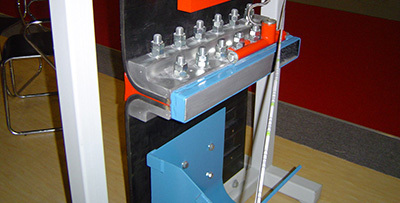News Center
Hezi technology focuses on the research and development of "rapid seamless conveyor belt joint sleeve" innovative technology project

NEWS CENTER

News Details
The Necessity of Durable Conveyor Rubber Belt Joints in Modern Industry
Release time:
2025-05-26
The Necessity of Durable Conveyor Rubber Belt Joints in Modern Industry Understanding Conveyor Rubber Belts: A Brief Overview Conveyor systems are integral to the smooth operation of many industries, including manufacturing, mining, and logistics. At the heart of these systems are conveyor rubber belts, designed to transport materials efficiently. The durability of these belts is often tested by t
The Necessity of Durable Conveyor Rubber Belt Joints in Modern Industry
Understanding Conveyor Rubber Belts: A Brief Overview
Conveyor systems are integral to the smooth operation of many industries, including manufacturing, mining, and logistics. At the heart of these systems are conveyor rubber belts, designed to transport materials efficiently. The durability of these belts is often tested by the harsh environments they operate in and the weight of the materials they carry. Thus, understanding the **construction and functionality** of conveyor rubber belts is essential.
What Are Conveyor Rubber Belts Made Of?
Conveyor rubber belts are primarily composed of rubber, which is then reinforced with fabric (like polyester or nylon) or steel. This combination offers flexibility, strength, and resilience against wear. These belts are engineered to handle a range of materials, from delicate items to heavy aggregates.
The Role of Joints in Conveyor Belts
Joints are crucial components of conveyor belts. They not only connect belt ends but also play a significant role in the overall strength and durability of the conveyor system. The quality of joints can directly impact the performance and longevity of the belt.
Why Durable Conveyor Rubber Belt Joints Matter
In modern industry, the importance of robust conveyor rubber belt joints cannot be overstated. Here are several reasons why they are essential:
1. Enhanced Reliability and Performance
Durable joints improve the reliability of conveyor systems. A strong joint minimizes the risk of belt failure, which can lead to **unplanned downtime** and disruption in operations. Reliable joints ensure that materials are transported smoothly and consistently.
2. Cost-Effectiveness
Investing in high-quality conveyor rubber belt joints can lead to substantial cost savings over time. When joints are designed to withstand the rigors of industrial use, they reduce the frequency of replacements and maintenance. This results in lower operational costs and improved efficiency.
3. Safety Considerations
Weak or improperly constructed joints can pose safety hazards. A conveyor belt failure can lead to injuries, equipment damage, and loss of materials. Durable joints help mitigate these risks, ensuring a safer working environment.
4. Adaptability to Harsh Conditions
Modern industries often expose conveyor systems to extreme conditions, such as high temperatures, humidity, and heavy loads. Durable joints are engineered to withstand these challenges, maintaining performance without compromising safety or efficiency.
Different Types of Conveyor Rubber Belt Joints
Understanding the various types of conveyor rubber belt joints can help in selecting the right one for your application.
1. Mechanical Joints
Mechanical joints use metal fasteners to connect belt ends. They are easy to install and provide a reliable connection, making them suitable for many applications.
2. Vulcanized Joints
Vulcanization is a chemical process that provides a seamless joint by bonding the belt ends together. This method results in a stronger joint that mimics the original belt’s properties, making it ideal for high-load applications.
3. Cold Bonded Joints
Cold bonded joints use adhesives to bond belt ends, requiring less equipment and energy. While not as durable as vulcanized joints, they can be effective for less demanding applications.
Best Practices for Maintaining Conveyor Rubber Belt Joints
Proper maintenance can significantly extend the life of conveyor rubber belt joints. Here are some best practices:
1. Regular Inspections
Conduct regular inspections of conveyor belts and joints to identify any signs of wear or damage. Early detection of issues can prevent costly repairs and downtime.
2. Proper Alignment
Ensure that conveyor belts are aligned correctly. Misalignment can lead to uneven wear on joints and increased stress, ultimately resulting in failure.
3. Cleanliness
Keep the conveyor system clean. Debris can accumulate around joints, leading to wear and potential failure. Regular cleaning can help mitigate this risk.
4. Training Personnel
Train staff on best practices for operating and maintaining conveyor systems. Knowledgeable personnel can identify potential issues before they escalate, preserving the integrity of the joints.
Choosing the Right Conveyor Rubber Belt Joints for Your Needs
Selecting the appropriate conveyor rubber belt joints is crucial for optimizing performance. Here are some key considerations:
1. Load Requirements
Determine the maximum load the conveyor will carry. Different joints are rated for varying load capacities, and selecting the right one ensures reliability and durability.
2. Environmental Factors
Consider the operating environment, such as temperature, humidity, and exposure to chemicals. Ensure that the chosen joints can withstand these conditions.
3. Installation Process
Evaluate the installation process. Some joints require specialized equipment, while others can be installed with basic tools. Choose a joint type that aligns with your operational capabilities.
4. Budget Constraints
While it’s essential to invest in quality, balancing performance with budget constraints is critical. Consider the long-term benefits of durable joints against initial costs.
Technological Advancements in Conveyor Rubber Belt Joints
Recent advancements in technology have improved the quality and performance of conveyor rubber belt joints. Innovations include:
1. Smart Monitoring Systems
These systems utilize sensors to monitor the condition of conveyor belts and joints in real-time. They provide valuable data that can predict failures before they occur.
2. Enhanced Materials
The development of new rubber compounds and reinforcement materials has led to more durable and flexible joints, capable of handling extreme conditions.
3. Eco-Friendly Options
With increasing environmental concerns, some manufacturers now offer eco-friendly conveyor rubber belt joints made from sustainable materials, reducing the carbon footprint.
Conclusion: Investing in Durable Conveyor Rubber Belt Joints is Essential for Success
In conclusion, the importance of durable conveyor rubber belt joints in modern industry cannot be overstated. They enhance reliability, improve safety, and offer cost-effective solutions for material handling challenges. Investing in high-quality joints tailored to specific operational needs is essential for achieving optimal performance and longevity in conveyor systems. Regular maintenance and the adoption of best practices can further enhance the effectiveness of these critical components. As technology continues to advance, staying informed about the latest developments will ensure that your conveyor systems remain competitive and efficient in an ever-evolving market.
FAQs
1. What factors affect the lifespan of conveyor rubber belt joints?
The lifespan of conveyor rubber belt joints can be affected by load weight, environmental conditions, maintenance practices, and the quality of the joint materials.
2. How often should conveyor rubber belts be inspected?
Regular inspections should be conducted at least once a month, with more frequent checks recommended for high-load or harsh environment applications.
3. Can I replace a damaged joint on my conveyor belt myself?
While some joints can be replaced with basic tools, it is advisable to consult with a professional for complex installations or when using advanced joint types like vulcanized joints.
4. What is the best type of joint for heavy loads?
Vulcanized joints are generally the best choice for heavy loads due to their strength and seamless nature, which mimics the original belt's properties.
5. Are there eco-friendly options for conveyor rubber belt joints?
Yes, some manufacturers offer eco-friendly conveyor rubber belt joints made from sustainable materials, providing an environmentally conscious choice for businesses.

Recommend News





























